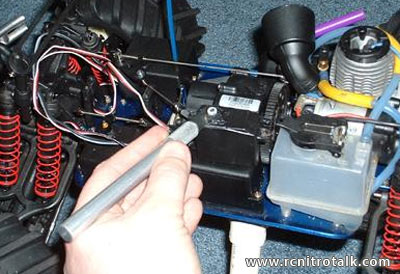Winter is here, and every year people ask in the forums, “How do I waterproof my rc?”. While most will not recommend operating your R/C through snow, ice, rain or mud – it is very possible to run in and through these condition IF you take the necessary steps in protecting your equipment. This quick and easy guide will show you a fool proof way of waterproofing your servos.
To start there are two things needed to use this method:
- X-acto knife, or razor
- Plasti Dip

[adsense468]
Plasti Dip is a flexible, synthetic, multi-purpose rubber coating that exhibits excellent moisture, acid, alkaline, and abrasion resistance and comes in various colors: black, red, blue, yellow, white, and clear. You can find Plasti Dip in most stores such as Home Depot, Lowes, Harbor Freight Tools, Menards and many other stores as well as online. Ok enough about Plasti Dip lets get on with the waterproofing!
RC Waterproofing Step 1:
Slowly insert your servo into the can of Plasti Dip. You do not need to coat the entire length of the wire however I would recommend covering at least an inch or two of it. This will ensure the entire servo is coated with the Plasti Dip and that the entry of the cable to the servo is also well protected.

RC Waterproofing Step 2:
Now slowly remove your servo from the can of Plasti Dip and allow your servo to drip dry. Plasti Dip recommends waiting 30 mins before applying another coat, however one coat should be all you need. You should wait 4 hours to allow the Plasti Dip to fully dry. While you're waiting repeat step 1 and 2 on all other servos.

RC Waterproofing Step 3:
Once you've allowed your servos to drip dry for 4 hours you can now take a x-acto knife or razor to cut way some of the Plasti Dip for your servo horns.

RC Waterproofing Step 4:
Now install the servo back in your R/C and you're ready to go tackle the great and wet outdoors!

The only other electric device not covered in this guide is your receiver. Using this method would require a lot of cutting out to allow the connectors to be plugged into the receiver. With most R/C's like the Monster GT, T-Maxx, and Savage have all placed the receiver in a protective box. These boxes are not waterproof but at least an ok guard from water. I'd recommend also using the ballooning trick for the receiver. Plug everything into the receiver as needed then place the receiver in a balloon and then tie or zip-tie the end shut. This should give adequate protection needed for the receiver.
You can also use the balloon method for your servos as well however your servos are usually out in the elements much more then a receiver thus doesn't have near the protect and a balloon is easily ripped or torn, plus a balloon doesn't look nearly as cool as a plasti dipped servo!


